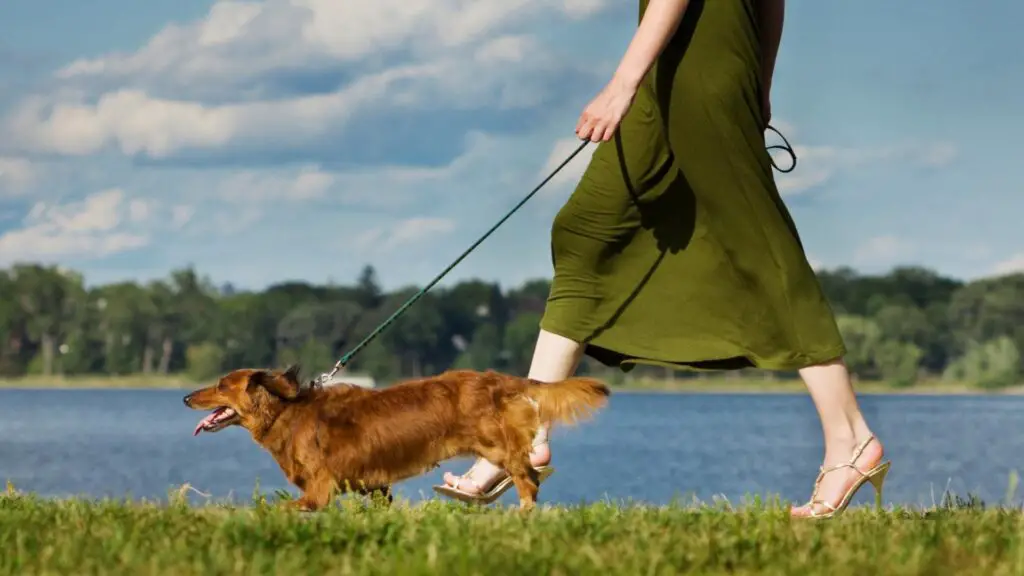Pawscessories is reader-supported. When you buy via links on our site, we may earn an affiliate commission at no cost to you.
Learn more.
A common problem people have is when their dachshund refuses to walk. Whether they roll on their back or sit and resist any forward movement, it can get old fast!
Is it normal for dachshunds to refuse to walk or is something wrong?
Why Dachshunds Refuse To Walk:
Dachshunds will refuse to walk when they’re in pain, afraid or too tired to continue. For dachshund puppies walking is a completely new experience that is totally unfamiliar to them. Which makes them hesitant. Older dachshunds have a higher chance of being in pain or too tired.
In this post you’ll discover:
- 9 reasons why your dachshund is refusing to walk
- When your dachshund refusing to walk is something to worry about
- 7 tips to help get your dachshund walking (Tip #4 is the easiest fix!)
- And much more
Let’s jump right in.
Table of Contents

9 Real Reasons Why Your Dachshund Is Refusing To Walk
1) Unknown Pain
If your dachshunds refusal to walk is new behavior then the reason for it could be that they’re in pain.
There are a few pains/injuries that your pup could have that would make them uninterested in walking.
The first place to check is their paw pads.
Their paws are completely exposed to the environment.
Unless you have your pup wear little booties they’ll have a chance of being cut, scraped, burned on a hot summer’s day or something could be lodged in their paw pads.
During your initial inspection you’ll want to make sure each of their paw pads look to be in good condition.
The next place to check would be anywhere their walking gear rests.
If you use a collar, it would be around their neck.
If you use a harness, it would be around their under arms and chest.
Sometimes, if the fit isn’t right, these things can cause rubbing which becomes very uncomfortable.
So much so that your dachshund will refuse to continue to walk because of the rubbing pain.
The last possibility could be that your pup has an underlying health issue that’s causing them pain.
Of course this would be next to impossible for you to spot unless they were also behaving weirdly in other situations.
It’s best to have a vet take a look at them if you have a hunch that they might have something going on internally.
2) Still Young

If you’ve recently adopted a dachshund puppy they may not be ready to walk long, or any, distances outside just yet.
Because they’re so small the outside world can be quite intimidating to them at first.
Which is why it’s a good idea to get them used to walking on their leash inside your home before venturing outside.
They also likely have lots of little growing pains because they’re just a pup.
Which means they may randomly shut down because their bones and joints start aching.
Not because they injured something, simply because their body is going through a major growth spurt which can make walking uncomfortable.
3) Not Ready For The Fun To Stop
If you’re noticing your dachshund mostly refuses to walk when you’re on your way home, it could be because they don’t want the fun to stop.
They’ve had a great time at the park, or on their walk, and going home means the end of that fun.
So they start to drag their feet in hopes that you’ll stay outside and keep walking so the fun can continue.
4) Hasn’t Done Their Business Yet
This one is pretty self explanatory.
If your dachshund hasn’t relieved themselves yet they may not want to keep walking until they’ve found the perfect spot.
This can be frustrating because you’re standing there waiting for them to go while they’re just sniffing around trying to find the perfect place.
It’s best to just be patient in this situation and let them take their time.
Otherwise you may end up with an accident inside your home.
5) Not Used To New Walking Gear

If you just got your dachshund a new collar, harness or leash they may need some time to get used to it.
They may have had a bad experience with walking gear in the past that has left them hesitant to try it on again.
Or, it could simply be that something doesn’t feel right and it’s causing them discomfort.
It’s important to make sure that whatever walking gear you use fits properly and doesn’t rub anywhere it shouldn’t.
You should also give your dachshund some time to get used to the new gear by letting them wear it around the house for a bit before taking them on a walk.
If they’re used to wearing the new thing you’ve gotten them and know it’s comfortable, they should have no problem going outside in it.
But on the flip side, if it’s uncomfortable when wearing it inside, they may be resistant to using it outside.
Related Reading: Top 12 Best Harnesses For Dachshunds
6) Unfamiliar Walking Route
If you’re trying to take your dachshund on a new walking route they may be refusing to walk because it’s unfamiliar to them.
While going on a new route can be exciting, many dogs simply enjoy the routine of smelling the same smells everyday.
If your dachshund seems to be more fussy on walks whenever going on a different route than usual, this might be why.
If you really want to go new places with your pup you’re better off adding some new to their familiar walking route.
Which means go your regular route then make a small detour.
Which will make a small portion of their walk unfamiliar and get them used to being in new environments.
Once you do this enough you can increase how many ‘new’ routes you bring your pup on compared to being on their familiar route.
7) General Fearfulness or Anxiety

For some dachshunds, the simple act of walking can be anxiety inducing.
This could be due to a traumatic experience such as being pulled too hard on their leash or getting scared by something while out on a walk.
In either case, it’s important to take things slow and not force your dachshund to do anything they’re not comfortable with quite yet.
You may need to start by just walking around your yard with them.
Or going on short walks around the block until they get more comfortable with the idea of walking.
If you have a fearful or anxious dachshund it’s important to train with positive reinforcement techniques.
Shouting, being forceful or getting angry will only make the situation worse for your pup.
Related Reading: 11 Reasons Why Dachshunds Get So Anxious + Tips To Help
8) Too Tired To Continue
This one is pretty straight forward.
Dogs, just like humans, can get tired while walking and may need a break.
If your dachshund starts to lag behind or sit down while on a walk it could be because they’re tired and need a rest.
It’s important to listen to your dog in this situation and not push them to keep going if they’re really tired.
Take a break with them and let them rest for a bit before continuing on your walk.
You may need to adjust the length or pace of your walks if this is something that happens frequently.
Related Reading: Dachshunds & Running: 3 Facts, 3 Dangers & 4 Tips
9) Getting Older
As your dachshund gets older they may start to slow down and have a harder time walking long distances.
This is normal and nothing to be worried about as long as your dog is still enjoying themselves.
If you notice your dachshund having a hard time on walks it’s important to adjust accordingly.
You may need to reduce the length or pace of your walks to make it more comfortable for them.
Top 7 Tips To Help Get Your Dachshund Walking

1) First & Foremost: Don’t Pull
Pulling is one of the least beneficial things you can do if your dachshund is refusing to walk.
Pulling on your end only makes your pup want to dig in and pull the other way.
It’s basically an extension of playing tug-of-war with one of their toys.
They see it as a game they want to win.
And the only real way to win the game is to stop playing it altogether.
Related Reading: 7 Secrets To Stop Leash Pulling In Just 10 Minutes Per Day
2) Socialize, Socialize, Socialize
The best way to get your dachshund used to walking is to start socializing them early on.
This means taking them out often, even if it’s just around the block.
The more they’re exposed to different sights, sounds and smells the less scary walking will be for them.
It’s also important to introduce them to different types of surfaces so they’re not afraid to walk on something new.
Grass, pavement, dirt, sand, etc.
The more they experience the less fearful they’ll be of new things.

3) Only Pick Them Up In This Situation
Picking up your dachshund and carrying them is only going to make the problem worse in the long run.
They’ll start to see it as a way to avoid walking altogether.
The only time you’d want to pick them up would be to take them a block or two away from your home.
This way they’re more motivated to walk because they want to get back home.
4) Ensure Their Walking Gear Is Comfortable
If your dachshund is uncomfortable while wearing their collar, harness or leash they’re going to be less likely to want to walk.
This is why it’s important to make sure their walking gear fits properly and isn’t too tight or loose.
Too tight and it will be restricting which makes it uncomfortable.
Too loose and it will start rubbing and causing chaffing which is also uncomfortable.
Whether it’s a harness or collar you want to make sure you can comfortably get two fingers in between their body and their collar/harness.
This ensures it’s snug enough to be safe but not too snug where it’s overly restrictive.
Related Reading: Top 12 Best Harnesses For Dachshunds
5) Walk Before You Run
If your dachshund is a young pup, get them used to walking around in their collar/harness inside the house.
It’s also a good idea to attach their leash and walk around with them this way in your home.
This way they’re getting used to the sensation of having something around their neck/body and being directed on a leash.
You can also try this in your backyard if you have one.
Then move on to short walks around the block before you attempt longer walks.
Eventually they’ll be completely comfortable with walking and you shouldn’t find them refusing to walk due to fear/discomfort anymore.
6) Drive Somewhere Away From Home
If your dachshund is still refusing to walk, you can try driving them somewhere away from home.
This could be a nearby park or even just a different neighborhood.
The change in scenery may be enough to motivate them to want to walk around and explore.
Plus, they won’t have the option of just sitting there and refusing to move because you’ll be carrying them.
You can also try this tip if you live in an apartment and don’t have easy access to different neighborhoods or parks.
Just driving to a different part of town could do the trick.
7) Vet Check Up
If you’ve tried everything and your dachshund is still refusing to walk, it’s time for a vet check up.
There could be an underlying health condition that’s causing them pain or discomfort when walking.
This is especially true if they’re older.
Arthritis, hip dysplasia and other age-related issues can make walking painful for them.
A vet will be able to determine if there’s a health issue causing your dachshund to refuse to walk and offer treatment options.
Other posts you might find interesting:
12 Best Dog Beds for Dachshunds
Dachshund Reverse Sneezing: Why It Happens & What To Do
